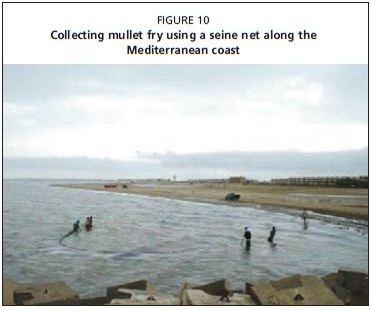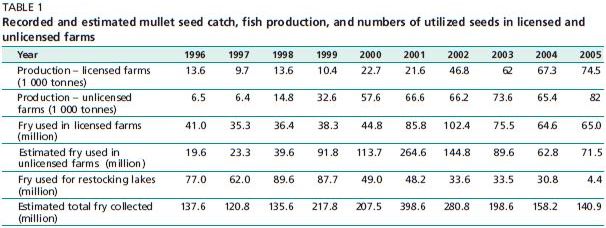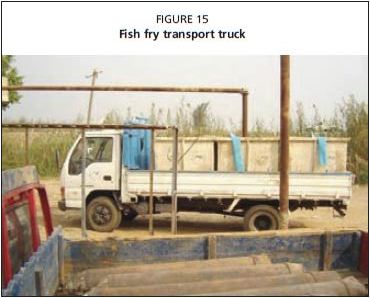WILD SEED FISHING
Legal aspects
In Italy, the collection of wild fry is managed by the authorities that issue limited fishing licenses each year between September 16 and December 31 after an assessment of relevant environmental parameters. Each licensee is allowed a quota of fry catch. Fishing is prohibited at the outlets of rivers and in brackish lagoon channels up to 400 m from the sea. Fishers must be equipped with oxygen supplied transport tanks (Sadek and Mires, 2000).
In Israel, special licenses are required to collect wild mullet fry. The department of fisheries and aquaculture, which also monitors the implementation of the law by means of inspectors, issues these licenses on a yearly basis. No fishing quotas are established (Sadek and Mires, 2000).
Wild fry collection in Egypt is controlled by the Fisheries Law No. 124/1983. According to this law, it is prohibited to fish, collect, handle or transport wild fish fry unless an official permit is obtained from the competent governmental authority (i.e. GAFRD). Fishing for wild fry is also allowed in limited sites supervised and managed by the governmental fry collection stations. Fry collection stations are distributed mainly on the Delta coast of the Mediterranean especially at the outlets of the major agriculture drainage canals, branches of the Nile and the connecting canals of lagoons and lakes to the sea. The mullet harvest at the ten Mediterranean stations is mainly flathead and thinlip grey mullet (98.9 percent of the total mullet fry catch in 2005). Two other stations at the Great Better Lake (Suez Canal) and the Gulf of Suez specialize in bluespot mullet.
Fry collection is conducted by teams of private fishers. The team leader and the teams are nominated and checked by the Coast Guard Intelligence before receiving a permit to work in the coastal areas. Each collection station may employ one or more teams. Fishers bring their own fishing gear and other collecting and handling equipment. All the collected fry are brought to the station where the catch is inspected for condition, presence of unwanted species and quantified by estimating the number of fish. Fishers are paid 50 percent of the sale price of the collected fry. The other 50 percent is kept for covering the running cost and maintenance of the stations.
The fry collection stations also act as the distribution and marketing sites for wild fry. Fry price is decided by the government authority and may fluctuate each year according to market demand. Changes in prices are decided and announced by a GAFRD board decree. Collected fry are usually sold directly or transported to GAFRD nursing stations where they are grown out and sold as fingerlings. According to local legislation, fry and fingerlings are sold only to licensed fish farms. Each fish farm is allocated a quota of 6 250–7 500 fry/ha of flathead or thinlip grey mullet or up to 12 500 fry of bluespot mullet. This quota system has created numerous management and control problems. In fact many mullet farmers state that the quota decided by the authority is much less than what is effectively required for a profitable production. The government authority, on the other hand, considers the quota to be more than enough if the farmers carry out the recommended handling, acclimatization and nursing procedures that prevents heavy losses of fry. Mullets are usually produced in semi intensive polyculture with other fish where it only constitutes less than 20 percent of the reared stocks.
The development and expansion of aquaculture was motivated by high profitability that attracted many agriculture land owners, especially those with newly reclaimed land of marginal profitability, to shift to aquaculture. Due to the shortage of water and agriculture land resources in Egypt, the transformation of agriculture land to aquaculture is contrary to the relevant agriculture, irrigation and fisheries legislation. In a recent field survey carried out by GAFRD, Ministry of Environmental Affairs, and the Aquatic Police and Land Reclamation Authority, it was reported that 36 400 hectares of reclaimed agriculture land were used for aquaculture activities in two Delta Governorates. The 2005 GAFRD statistical yearbook estimated the total area of this activity at 55 200 hectares representing about 52 percent of the total aquaculture area of the country. According to current legislation, GAFRD cannot license such farms.
These farms are not allowed to purchase seed from the governmental hatcheries or fry collection stations and they can only depend on illegal sources for their stocking needs. The recorded mullet production from such farms was 82 000 tonnes in 2005 (GAFRD, 2006) representing about 47 percent of the production of cultured mullet in the country.
As a result, fish farmers seek other sources of seed supply. This has created an illegal activity of fishing and marketing of wild-caught seed by gangs of illegal fishers. These unlicensed fishers sneak into the coastal areas or banks of drainage canals, well equipped with seine nets, light boats and pickup trucks. The illegally harvested fry are transported very early in the morning along country roads to a fry market in the fish farming areas where they are sold by the thousands. The number of fry collected through this illegal activity is not recorded and is uncontrolled. The size of this illegal trade is believed to be very large and the number of collected fry may exceed those collected through the official stations.
Fishing techniques
Mullet are known to have a seasonal breeding migration when large shoals of adults leave lakes, coastal lagoons and rivers and move to breeding grounds in the open sea. Breeding seasons differ according to species and regions of the world. Hatched larvae drift with surface water currents (Rossi, 1986) and then swim in large aggregations towards the shallow coastal waters to reach the rich feeding grounds in the estuaries and coastal lagoons. Mullet seed reach the estuaries and shallow coastal waters as fry that are 12–20 mm long. Mullet fry are fished as they reach the coast or from the inlets of the coastal lagoons and openings of agriculture drainage or irrigation canals.
In Egypt mullet have been commercially fished for restocking saline inland lakes since the early 1920s (Wimpenny and Faouzi, 1935; Faouzi, 1936). The Suez Canal, its adjacent lakes, the Nile effluents and discharge canals leading to the Mediterranean have been the main source of the seasonal mullet and other euryhaline fish fry catches (El-Zarka and Kamel, 1965). The early techniques used for commercial wild fry collection were described by El-Zarka, El-maghraby and Abdel-Hamid (1970). The gear was made from mosquito nets fitted to a rectangular metal frame with a wooden roll bar fixed to the front edge of the frame and pushed in the shallow coastal water by a team of three fishers. The reported fry catch of such gear was about 20 000 fry per hour. With the increased demand for fry in the late 1990s, shoals of fry were collected in coastal water using larger fine seine nets (Figure 10).
The commonly used seine is
Figure 10
Collecting mullet fry using a seine net along the Mediterranean coast

50–150 m wide and 2.25 m deep. Netting material is made of strong monofilament threads of synthetic fibers with 1 mm stretched mesh size (Figure 11). The material is manufactured mainly for household use, window and fishpond screens. The purchased material is prepared by the fishers by fixing cork and lead lines, side wooden bars and pulling ropes. Scoop nets are also used to collect fry from the agriculture drainage canals especially near the outlets of pumping stations leading to the sea (Sadek and Mires, 2000).
Collected fry are scooped from the fishing net by small fine hand nets, carried in buckets filled with seawater and kept in hapas or shore aggregation tanks for a few hours. At this point fry are sold to customers or moved to transport trucks to be sold at the fish farms. Fry are also transported by trucks to separate nursery units, or nursery facilities in grow-out farms to produce fingerlings.
Fry collection activities are carried out by artisanal fishers. Techniques are simple and the gear is developed from locally available materials. The highest cost is for the seine net. The cost of fabric is about US$60 and about US$50 for cork, ropes and lead. A light wooden boat can sometimes be used to stretch the net in deeper water (Figure 12). Such a boat can cost US$200–250 but it is used for other activities beside the seasonal and temporary fry collection. In an interview with a team leader working with the governmental station near Port Said, the overall cost of gear, equipment and fees were calculated to be around US$500–520 for each fishing cycle of 3–4 months. The season of mullet fry collection extends to 10 months in three cycles each year.
Annual data on mullet seed collection in Egypt is found in the GAFRD records for the last three decades. The annual catch of mullet fry during the early 1980s was around 50 millions per year (53.7 million in 1980). In 1985, the total number increased to 83.2 million fry. Most of the collected fry (64 percent) were used to stock inland lakes (culture based fisheries) the rest was used for aquaculture.
The magnitude of mullet fry collection activities varied greatly with the fluctuation in demand associated with the status of aquaculture development. Increase in the demand for seed was associated with the rapid development of aquaculture in the 1990s (Figure 13). The official record for the last 10 years is not comprehensive, as the illegal fry catch
Figure 11
Collected mullet fry are scooped by hand nets and transferred into buckets
Figure 12
A light wooden boat used to stretch out the seine net
Figure 13
Variation in number of wild-caught mullet seed from 1990–2005

TABLE 1
Recorded and estimated mullet seed catch, fish production, and numbers of utilized seeds in licensed and unlicensed farms

generally is unreported. According to GAFRD illegal fry collection has increased sharply during the last five years as a result of the unlicensed fish farms built illegally on newly reclaimed agriculture land.
The recorded catch of mullet fry during the past 15 years varied between 90–145 million fry per year with the highest catches in 1990 and 1992 when about 146 and 145 million fry were collected, respectively. Starting from 2003, fry catch began to decline. The sharp decline in 2005 was due to the reduced number of legally caught mullet seed used in restocking inland lakes, from 32 million in 2004 to about 4 million in 2005 (GAFRD, 2006). The recorded number of fry used for production on licensed farms can be used to extrapolate the number of fry used on unlicensed farms, as both apply the same technology and management systems.
In 1996, mullet production from unlicensed farms was estimated at 6 500 tonnes representing approximately 32 percent of the total cultured production, while in 2005 the harvest increased to 82 000 tonnes representing 52 percent of the annual output.
Table 1 show the recorded mullet production from both licensed and unlicensed farms from 1996 to 2005 along with the total recorded number of fry (all three species) officially collected during the same year. The table highlights the fact that mullet production is not related to the number of fry utilized.
Production from 2003 to 2005 increased even though the number of fry utilized dropped considerably. During this same period the government increased the price of fry from US$3.5 to 17.6 per thousand resulting in both positive and negative effects. On the positive side, it led to an improvement in fishing, transport, handling and acclimatization techniques and a more responsible and rational utilization of the resources. On the negative side, the increased profit from the sale of fry encouraged additional illegal fry fishing.
Table 2 indicates the change in the relative importance and number of collected seed from each of the three species farmed in Egypt. The data shows that the catch of Liza ramada seed was always the highest at about 59 percent of the total mullet seed collected in 2001 to over 79 percent in 2005. This was also the case in Greece where seed of this species was the most abundant and represented over 54 percent of mullet fry found (Koutrakis, 2004).
Table 2
Charges in the relative importance and number of collected seed of different mullet species

The percentage of Mugil cephalus declined during the same period from about 30 percent in 2001 to 11.5 percent in 2005 whereas the catch of Valamugil seheli was more stable. The decline in the catch of Mugil cephalus in 2002 was balanced by an increase in the catch of Liza ramada seed from 79 million in 2001 to a record of 101.5 million in 2002. Two reasons have been identified for the decline of Mugil cephalus fry. The first was the increased production of dried mullet roe and the second that most of the illegal seed fishing activities concentrated on the higher priced flathead grey mullet.
Figure 14
Ripe mullet ovaries extracted for roe production

Fishing mullet to extract the ovaries is an old practice, which is expanding rapidly in the Mediterranean, Asia and the United States of America (Figure 14). The activity is a real threat to the species considering the high fecundity of the flathead grey mullet. Each migrating ripe female killed to extract the ovaries means loosing 2–4 million eggs and at least many hundreds of thousands of seeds.
Mullet seed collection is carried out by men as are all other commercial fishing activities in Egypt. Women, on the other hand, are mainly involved with the manufacturing and repairing of the fishing gear. The mullet seed fishery is practised by resident fishers living in the coastal areas near the lakes and coastal lagoons. The activity is territorial and each group of fishers works in their area without intruding into neighboring areas.
Utilization of wild fry was known to be associated with a high seed mortality attributed to trauma of rough handling during collection and transport. As a result of effects initiated in the mid-1920s Egyptian experts attained extensive experience in handling mullet fry on a large-scale that dramatically reduced the losses during handling.
Fry collected using different fishing gear are usually retrieved in small buckets filled with seawater and collected in hapa cages or shore tanks. These aggregation tanks and hapas are also used to inspect the
catch and remove unwanted species
or traumatized fry. During sale, fry are scooped by hand nets, counted and emptied into polyethylene bags, insulated pickup trunks or loaded onto specialized fry transport trucks (Figure 15). Fry tanks (usually 1 m3) can carry up to 15 000 fry for a transport period of up to 4 hours and densities vary according to the travel distance. Cooling with ice bags is usually applied during summer.
If oxygen inflated bags are used, these can be carried on any vehicle. Owners of small farms usually carry 4–6 bags in the trunks of their cars. Each of the fry bags can carry up to
Figure 15
Fish fry transport truck

2 000–3 000 fry and are used for short distance transport (<2–3 hours). The bags are usually filled with 1/5 water and 4/5 compressed oxygen. If the bags are carried by pickup trucks, they are usually protected from the sun with rice straw mats sprayed with water for cooling. Fry are sometimes transported in plastic bags by motor boats if the farming site is near a water body.
Upon arrival, fry are usually acclimatized to the receiving pond environment. For transport in plastic bags, the bags are first immersed in the ponds and the contents eventually emptied. If transport was by pickup trucks, fry are first collected into plastic buckets. Dead and weak fry are usually removed and the number of stocked fry in each pond is recorded. If transport was by specialized trucks, a large volume of transport water is substituted with pond water before releasing fry into ponds.
High fry mortalities are reported in many farm sites as a result of insufficient acclimatization. In a three year study on the utilization of wild mullet fry for restocking inland lakes in Egypt (Kleijn, 1988), losses during transport (6–8 hours) varied between 0.9–1.4 percent. In the same study, the mortality of fry during four months in nursery ponds was up to 35 percent.
Saleh (1991) reported that mortality rates of 96 percent of the transported fry may occur during the first 7 days if the fry are directly transferred from seawater to the nursing ponds with a salinity level <2.6 ppt. Mortality was reduced to 6 percent through gradual (6–8 hours) acclimatization.
High losses can also be expected during the nursery period due to inadequate pond preparation and management. Most of the losses are associated with predation by other fish (African catfish, Clarias gariepinus, and the red bellied tilapia, Tilapia zilli) commonly found in poorly prepared ponds. Large losses also occur in heavily fertilized ponds due to oxygen depletion and during the harvesting of the fingerlings.